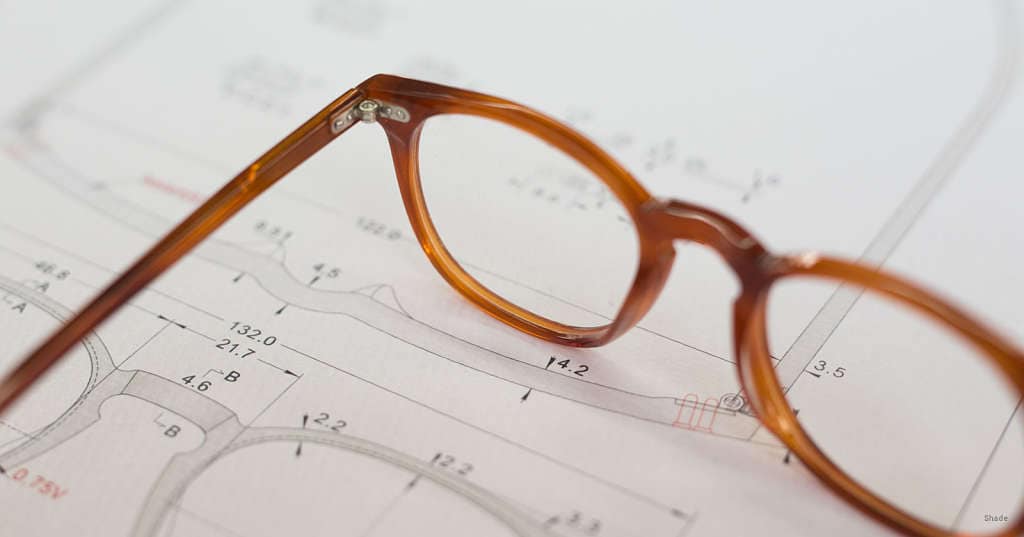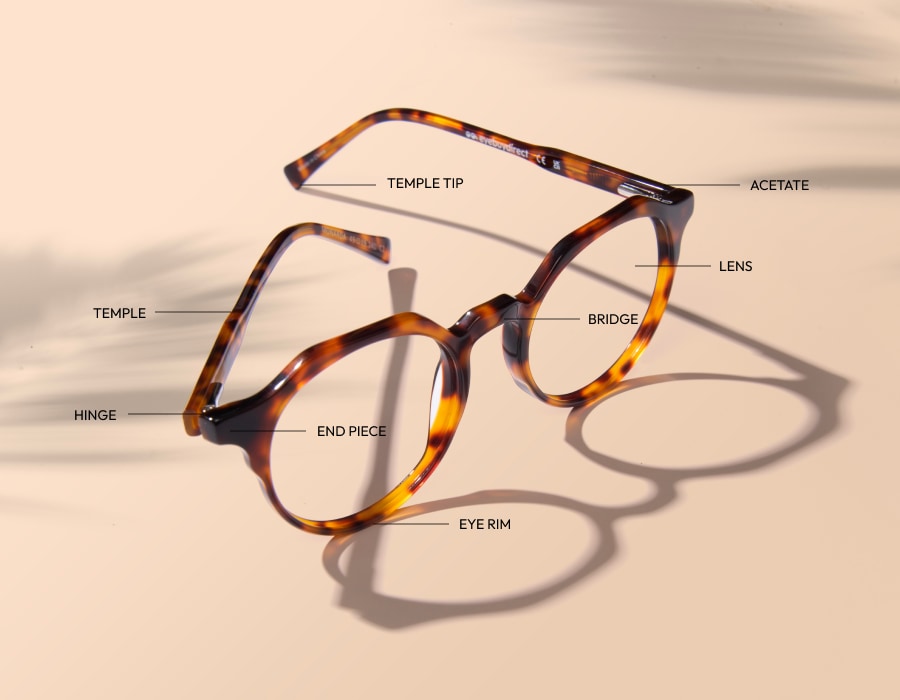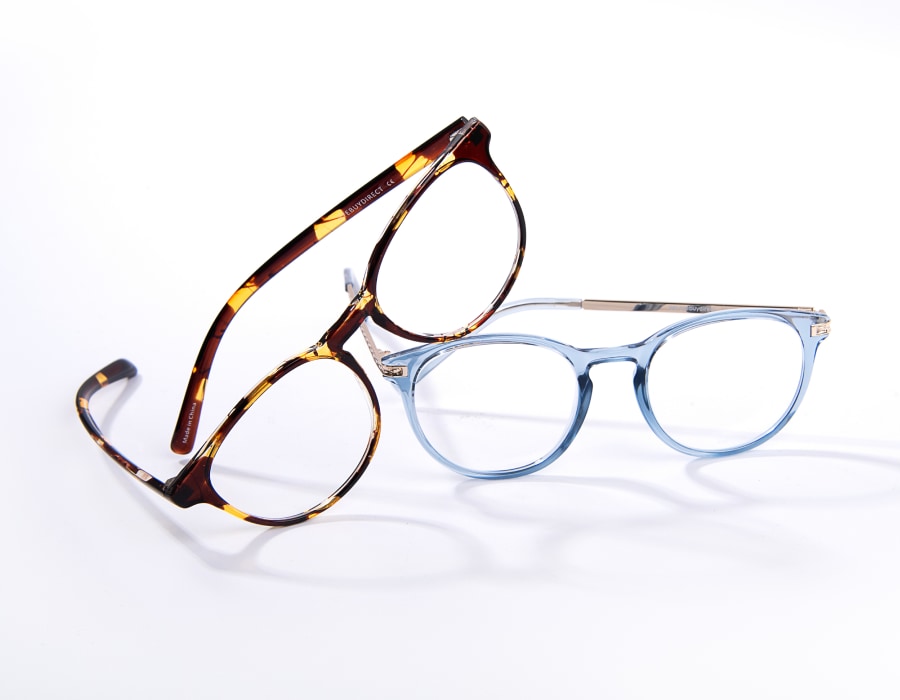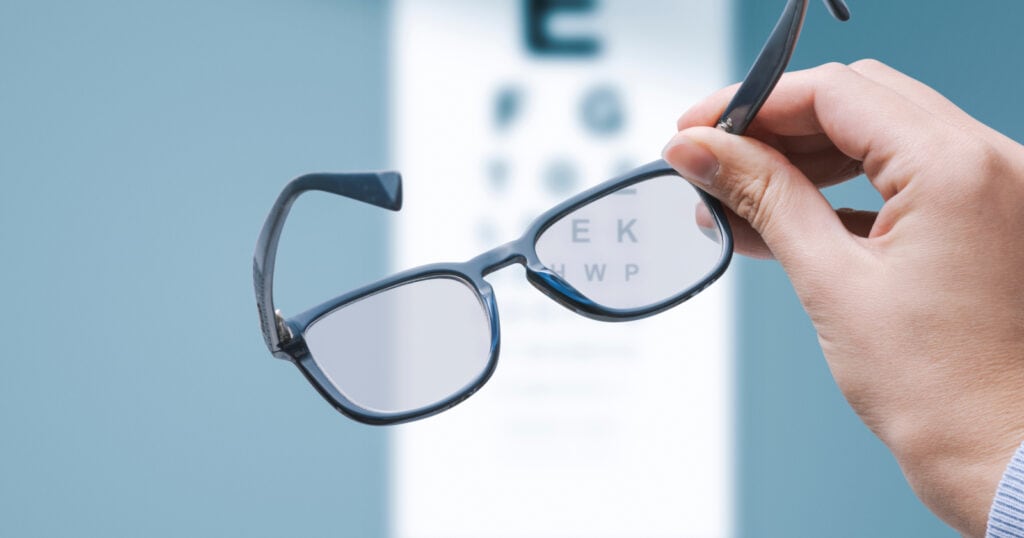Eyeglasses are one of the few accessories that have a specific purpose beyond just looking good. Many of us need them to see distant objects or to read small print, especially as we age. Despite their importance in our lives, most people know very little about their eyewear, such as the various parts and functions of an eyeglass frame.
While it may seem like there’s no reason to know these details about your glasses, basic knowledge of parts of glasses can help you to fix them if something happens. It can also help you determine whether they can be fixed, or if it’s time for a replacement pair.
Glasses Anatomy
If we could choose only one takeaway from this article, it would be the basic understanding of the parts of your eyeglasses frame versus the lenses. Every part of your sunglasses or eyeglasses that rests on your face or head when wearing them is a different part of the frame.
The glass or plastic parts that you look through are the lenses. The frame holds the lenses in place in front of your eyes.
Simple enough, right? Now, let’s break down each part, piece by piece, and examine its function.
The Frame
While there are many types of materials to choose from for your eyewear, the two most common types are a plastic frame and a metal frame. Eyeglasses and sunglasses have many parts that work together to make your eyewear functional and comfortable to wear.
Starting from the middle of the frame and working outward, here are the different glasses parts and what they do:
Bridge
The bridge is the part of the frame that sits on top of your nose. A part of sunglasses as well as glasses, it is a curved piece that joins the two sides together and connects the rims. It ensures even weight distribution for all-day comfort.
A frame’s bridge can be longer or shorter depending on the placement of the lenses and the distance between the wearer’s eyes. The height of the bridge can also vary. If you have trouble with glasses sliding down your nose, consider low nose bridge glasses when you get a new pair.
Nose pads
Nose pads significantly influence the fit and comfort of your glasses. They are typically made of plastic or silicone and rest on your nose to keep your glasses in place. Without them, glasses may slip or fit poorly, requiring constant adjustment.
There are two main types: adjustable and fixed. Adjustable nose pads, typically found on metal frames, can be molded for a better, more comfortable fit. Fixed nose pads are integrated into the frame, offering a cleaner appearance but lacking adjustability.
Rims
Rims, also called eye wires, secure the lenses and define the shape of your glasses. They come in many different shapes and sizes, and the lenses are customized to fit. Rims are available in various materials, each offering distinct advantages.
- Metal rims – Made from stainless steel, titanium, or aluminum, these rims are durable and stylish. They are lightweight and modern, making them popular.
- Plastic rims – Typically constructed from acetate, these rims are flexible and available in numerous colors. They are ideal for those who favor bold designs.
- Rimless and semi-rimless – These rims offer a minimalist look and are extremely light. They are perfect for those who prefer a minimalist style.
Hinges and Screws
Glasses hinges are located at the corners of the frames, working to connect the temples of the glasses to the end pieces. They allow the temples to swing inward and close, which allows for easy storage in a case or front pocket.
Hinges come in two main types: standard and spring. Standard hinges are the most common type. They fold inward to store your glasses, and when opened outward, the temples align perpendicularly with upper-outer corners of the rims.
Spring hinges provide additional flexibility, allowing the arms to hyperextend outward. This feature makes them suitable for active use because they help prevent breakage. Over time, you might encounter issues like loosening or misalignment, which can be remedied with a small screwdriver.
Temples and temple tips
Also called the arms, the temples are the sides of the glasses or sunglasses that sit over your ears and help keep your glasses on your face. The temple arms also hook behind your ears for a more secure fit. The depth or curve of the hook varies depending on the style and how your glasses have been adjusted to fit.
It’s important to note that your glasses measurements are usually stamped or engraved on the inside of the glasses arms. These measurements come in handy to help you determine what frame size fits best for your face shape and size.
Temple tips are plastic, silicone or rubber coverings placed over the ends of the temples. They are used to protect the frames and prevent the temples from rubbing against the skin behind your ears. They can also help hold your glasses in place. A temple tip can come in a stiff or pillowy material to fit different preferences and skin sensitivities.
When selecting a frame, consider both style and functionality. Whether you prefer bold plastic rims or sleek metal ones, your frame reflects your style. At Eyebuydirect, we provide a wide array of choices for everyone. Check out our selection of eyeglasses and sunglasses to discover your ideal pair.
Lenses
Lenses are plastic or glass pieces placed in front of the eyes, making them the focal point of your glasses. They allow the wearer to see more clearly by providing vision correction within the lenses.
Types of Lenses
There are different lens types to meet various vision needs. Clear or plano lenses have no prescription in them. This lens type is great for those who don’t need vision correction, but like the fashion statement glasses provide.
Single-vision lenses offer one consistent prescription across the entire lens, correcting either distance or near vision. Bifocal lenses provide two distinct correction zones, allowing you to see both near and far without changing glasses. Multifocal or progressive lenses incorporate multiple prescriptions in each lens and provide seamless vision from near to far without visible lines.
Besides being made with your individual prescription, an eyeglass lens can have certain lens coatings and/or treatments added to further meet your vision needs. Some of these treatments include anti-reflective coating to decrease glare. Light-sensitive and UV protective coating can safeguard your eyes from harmful sun rays, and scratch-resistant coating can extend the life of your lenses.
Lens Materials
The material of the lens impacts weight, strength, and clarity. Plastic lenses are lightweight and cost-effective, suitable for daily use. Polycarbonate lenses are more robust and impact-resistant, ideal for active individuals and children.
For thinner lenses with excellent clarity, high-index lenses are the best option. They are slimmer than standard lenses and are effective for strong prescriptions, minimizing bulk.
Whether you need basic or advanced options, Eyebuydirect offers an extensive selection to meet your vision needs. If the prescription is off or the lens tint you picked is not your vibe, we offer free returns within 14 days of receiving your purchase.
Choosing the Right Glasses
Choosing the right glasses extends beyond aesthetics. It involves selecting eyewear that complements your face and lifestyle.
Your face shape and skin tone play a crucial role in selecting glasses. Choosing frames that compliment your features is a great place to start when shopping for eyewear.
Your daily activities should also influence your eyewear choice. If you are active, opt for durable frame materials like titanium, with polycarbonate lenses. Outdoor enthusiasts may enjoy polarized sunglasses that reduce glare in bright environments.
While personal style is important, an optician’s advice is key. They assess your vision and recommend lenses that enhance comfort. Opticians ensure your glasses fit well, which guarantees comfort and functionality.
The process of selecting glasses should incorporate style, practicality, and expert advice. Consider your face shape and lifestyle and seek professional guidance. Find eyewear that looks great and enhances your daily life.
Now that you’re an aficionado of the parts of glasses, consider exploring Eyebuydirect’s extensive collection to find your own pair. Whether you need eyeglasses or sunglasses, we offer styles to suit diverse tastes and requirements. So, express your unique style with Eyebuydirect, where each pair is crafted just for you.







